Design of Power Splitters Based on Hybrid Plasmonic Waveguides
Abstract
:1. Introduction
2. Materials and Methods
3. Results and Discussion
4. Conclusions
Author Contributions
Funding
Institutional Review Board Statement
Data Availability Statement
Conflicts of Interest
References
- Ozbay, E. Plasmonics: Merging Photonics and Electronics at Nanoscale Dimensions. Science 2006, 311, 189–193. [Google Scholar] [CrossRef] [PubMed]
- Zia, R.; Schuller, J.A.; Chandran, A.; Brongersma, M.L. Plasmonics: The next chip-scale technology. Mater. Today 2006, 9, 20–27. [Google Scholar] [CrossRef]
- Oulton, R.F.; Sorger, V.J.; Genov, D.A.; Pile, D.F.P.; Zhang, X. A hybrid plasmonic waveguide for subwavelength confinement and long-range propagation. Nat. Photonics 2008, 2, 496–500. [Google Scholar] [CrossRef] [Green Version]
- Kinsey, N.; Ferrera, M.; Shalaev, V.M.; Boltasseva, A. Examining nanophotonics for integrated hybrid systems: A review of plasmonic interconnects and modulators using traditional and alternative materials. JOSA B 2015, 32, 121–142. [Google Scholar] [CrossRef]
- Wen, K.; Hu, Y.; Chen, L.; Zhou, J.; Lei, L.; Guo, Z. Design of an optical power and wavelength splitter based on subwavelength waveguides. Lightwave Technol. 2014, 32, 3020–3026. [Google Scholar] [CrossRef]
- Butt, M.A.; Khonina, S.N.; Kazanskiy, N.L. Ultra-short lossless plasmonic power splitter design based on metal–insulator–metal waveguide. Laser Phys. 2019, 30, 016201. [Google Scholar] [CrossRef]
- Ghasemi, M.R.; Bayati, M.S. Proposal for metal–insulator–metal plasmonic power splitter and demultiplexer suitable for implementation in optical switches. IET Optoelectron. 2021, 15, 200–206. [Google Scholar] [CrossRef]
- Wahsheh, R.A. Ultra-compact broadband 3-db metal–dielectric-metal plasmonic power splitter. J. Mod. Opt. 2021, 68, 153–160. [Google Scholar] [CrossRef]
- Nozhat, N.; Granpayeh, N. Analysis of the plasmonic power splitter and MUX/DEMUX suitable for photonic integrated circuits. Opt. Commun. 2011, 284, 3449–3455. [Google Scholar] [CrossRef]
- Chen, C.H.; Liao, K.S. 1xN plasmonic power splitters based on metal-insulator-metal waveguides. Opt. Express 2013, 21, 4036–4043. [Google Scholar] [CrossRef] [PubMed]
- Ayad, M.A.; Obayya, S.S.A.; Swillam, M.A. Submicron 1xN ultra wideband MIM plasmonic power splitters. Lightwave Technol. 2014, 32, 1814–1820. [Google Scholar] [CrossRef]
- Ayad, M.A.; Swillam, M.A. Mid-infrared plasmonic power splitters. IEEE Photonics Technol. Lett. 2016, 28, 2431–2434. [Google Scholar] [CrossRef]
- Chang, Y.; Chen, C.-H. Design of a broadband plasmonic unequal-power splitter with a rectangular ring resonator. Plasmonics 2015, 10, 739–743. [Google Scholar] [CrossRef]
- Guo, Y.; Yan, L.; Pan, W.; Luo, B.; Wen, K.; Guo, Z.; Li, H.; Luo, X. A plasmonic splitter based on slot cavity. Opt. Express 2011, 19, 13831–13838. [Google Scholar] [CrossRef] [PubMed]
- Ye, Y.; Xie, Y.; Song, T.; Wang, Y.; Chai, J.; Liu, B.; Liu, Y. Design of a Novel Plasmonic Splitter with Variable Transmissions and Selectable Channels. IEEE Trans. Nanotechnol. 2019, 18, 617–625. [Google Scholar] [CrossRef]
- Palik, E.D. Handbook of Optical Constants of Solids; Academic Press: New York, NY, USA, 1985. [Google Scholar]
- Bian, Y.; Gong, Q. Metallic-nanowire-loaded silicon-on-insulator structures: A route to low-loss plasmon waveguiding on the nanoscale. Nanoscale 2015, 7, 4415–4422. [Google Scholar] [CrossRef] [PubMed]
- Soldano, L.B.; Pennings, E.C.M. Optical Multi-Mode Interference Devices Based on Self-Imaging: Principles and Applications. Lightwave Technol. 1995, 13, 615–627. [Google Scholar] [CrossRef] [Green Version]
- Shi, X.; Yang, W.; Xing, H.; Chen, X. Discrete plasmonic Talbot effect in finite metal waveguide arrays. Opt. Lett. 2015, 40, 1635–1638. [Google Scholar] [CrossRef] [PubMed]
- Yariv, A.; Yeh, P. Photonics: Optical Electronics in Modern Communications; Oxford University Press: New York, NY, USA, 2007. [Google Scholar]
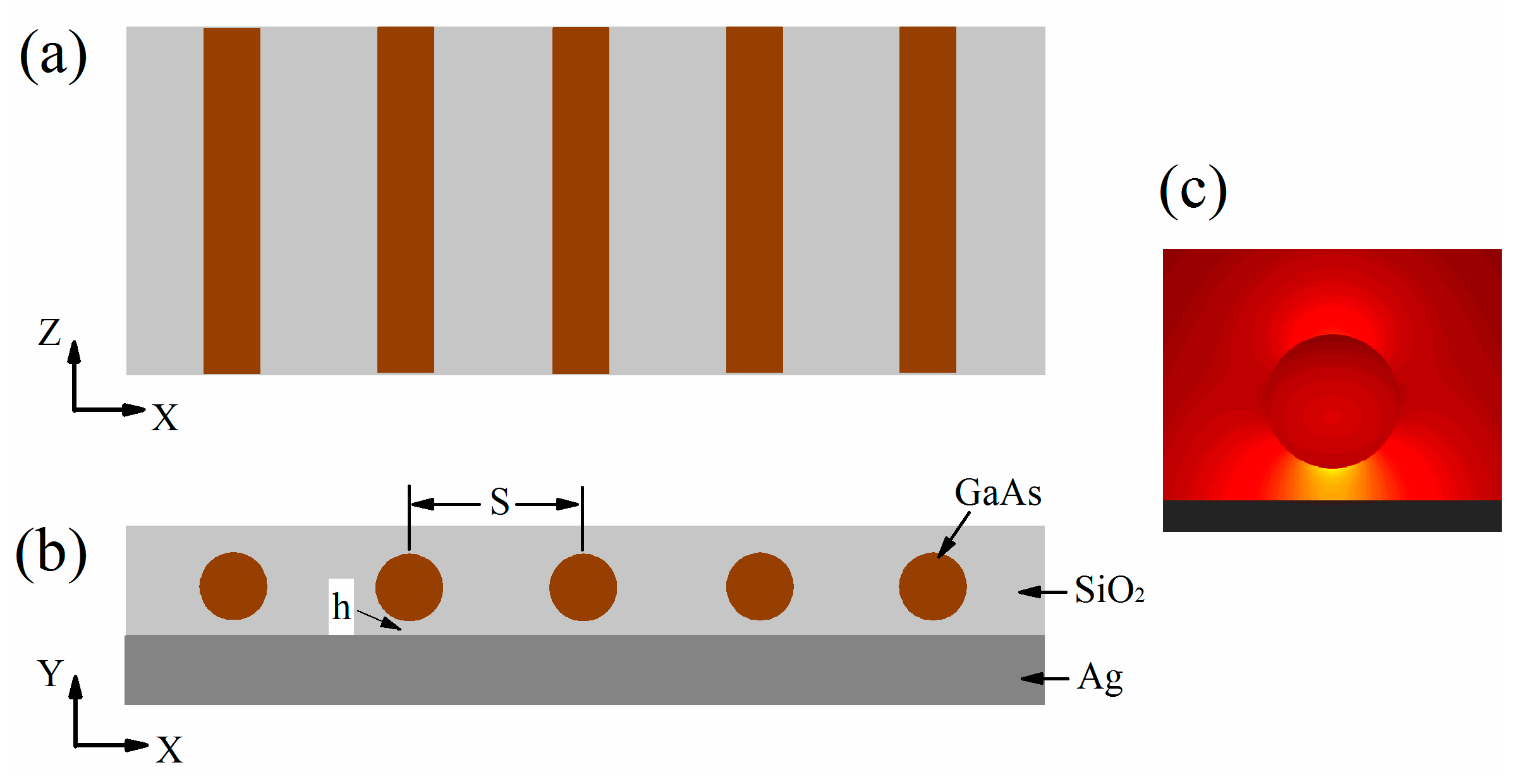
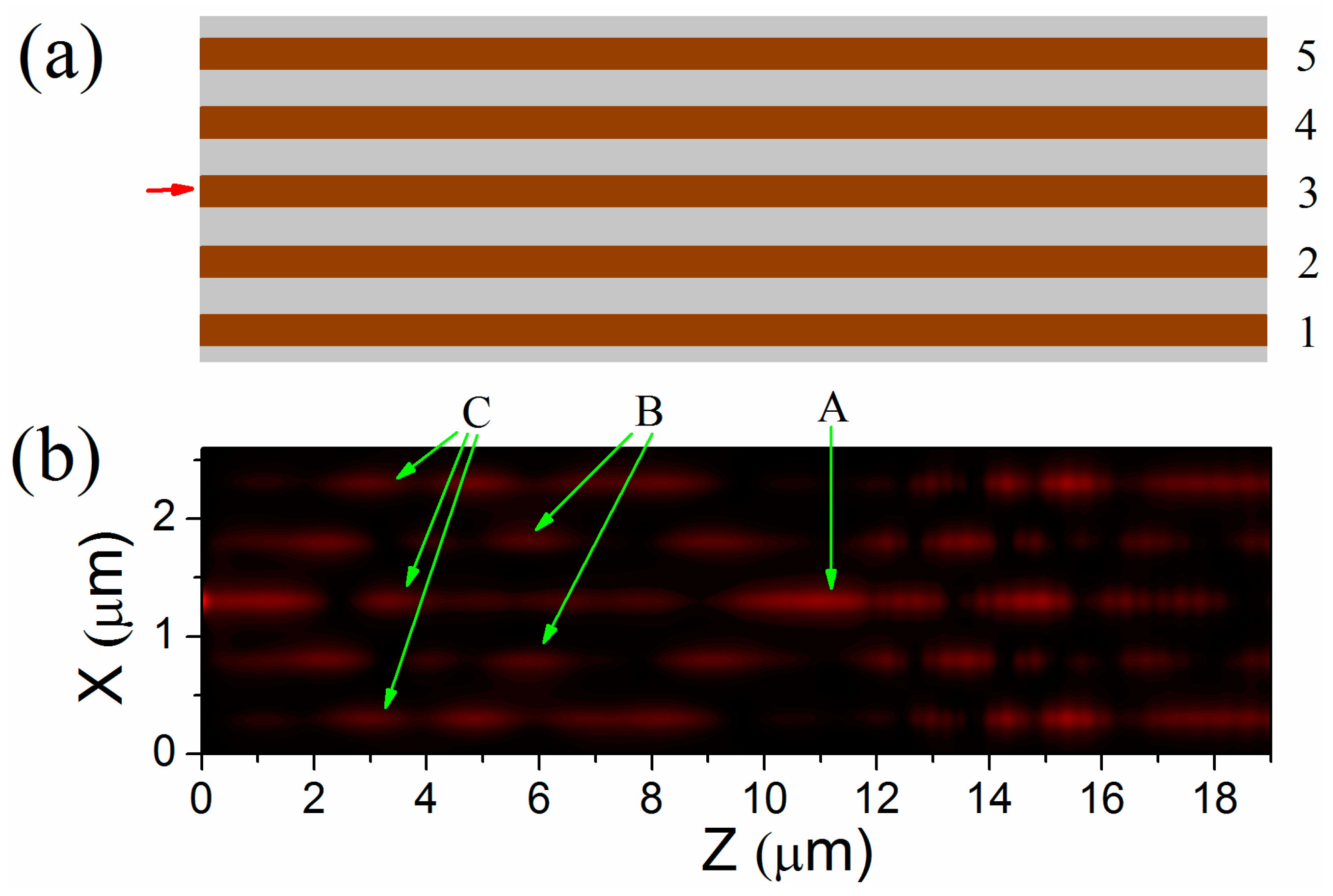

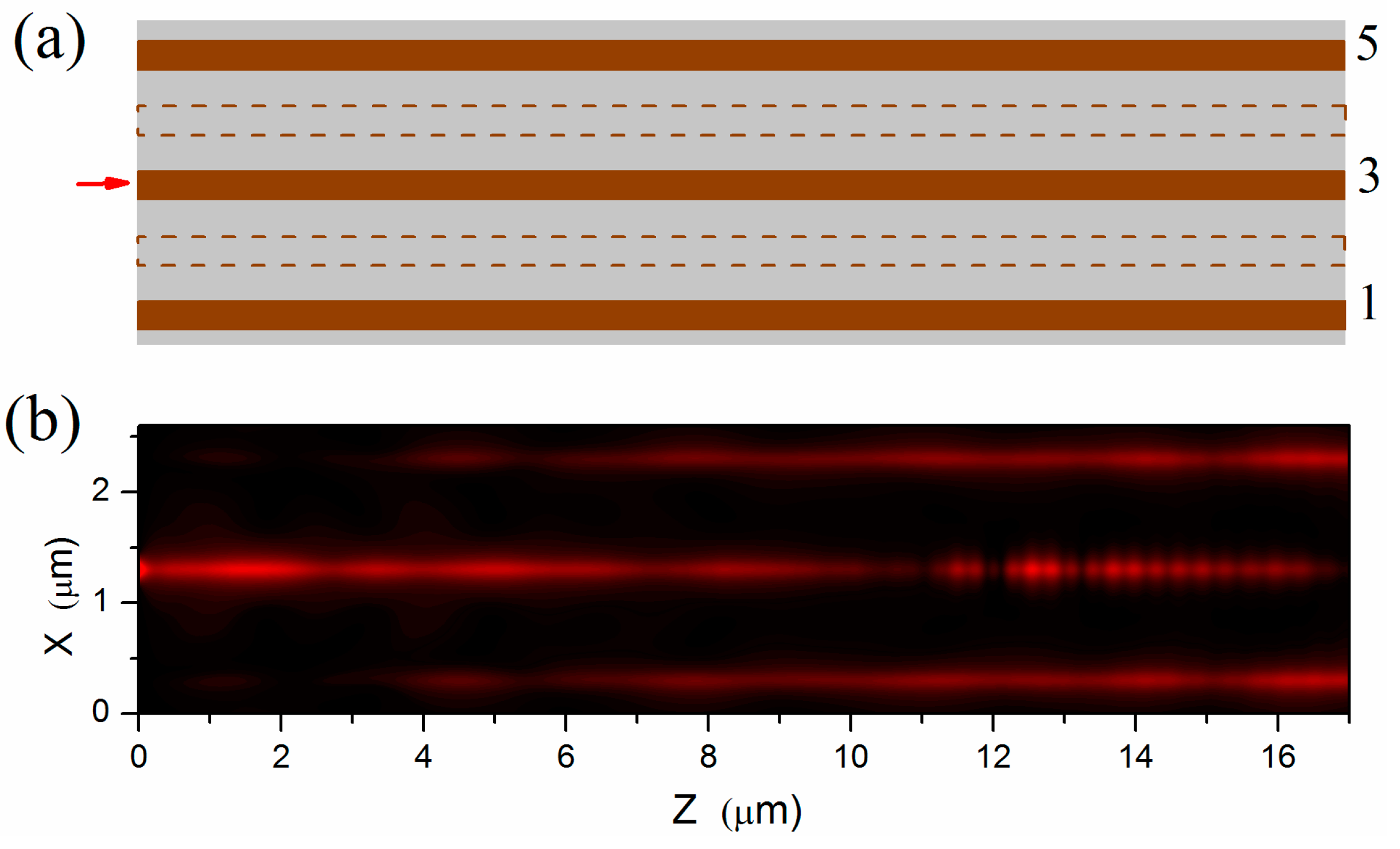
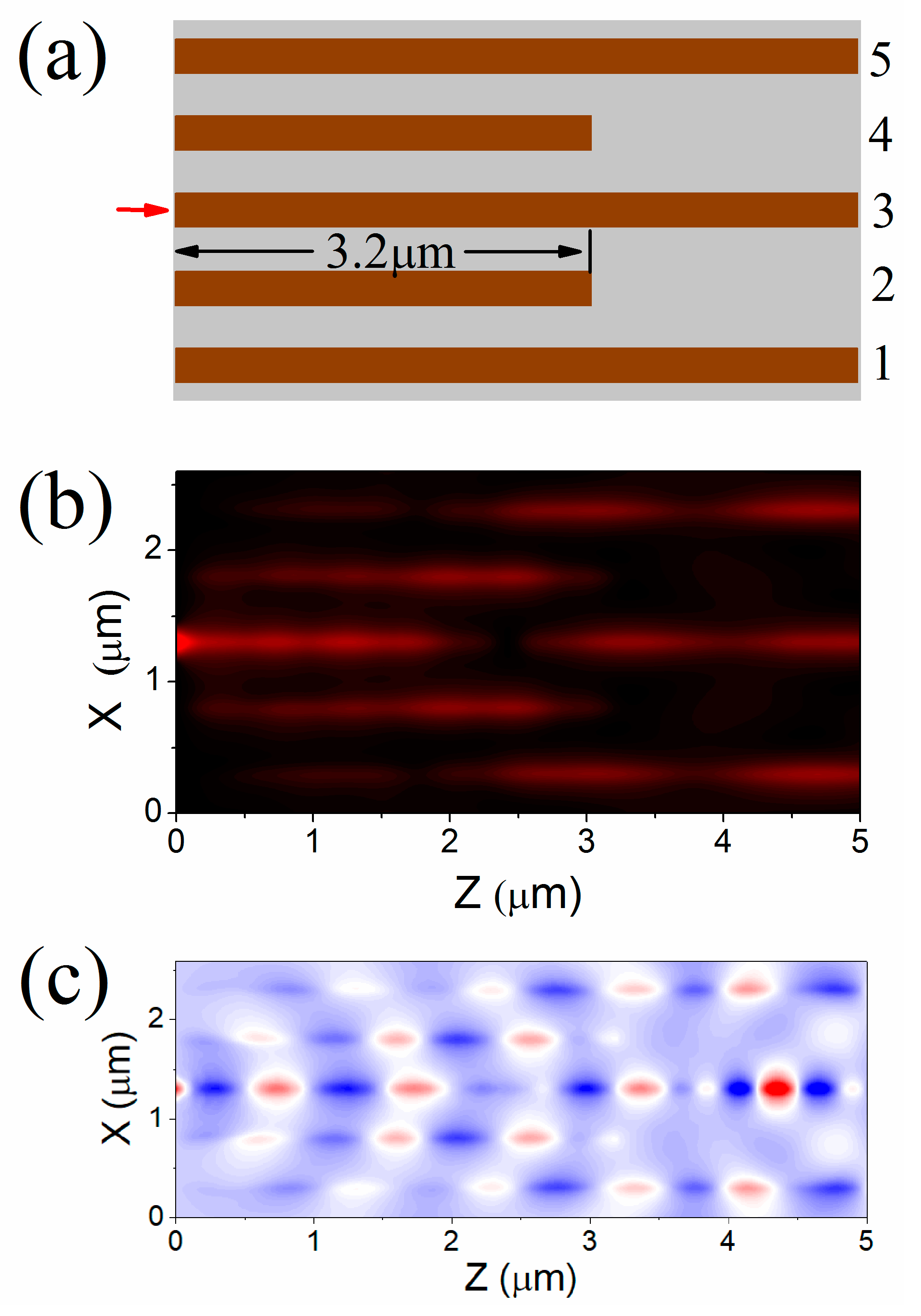

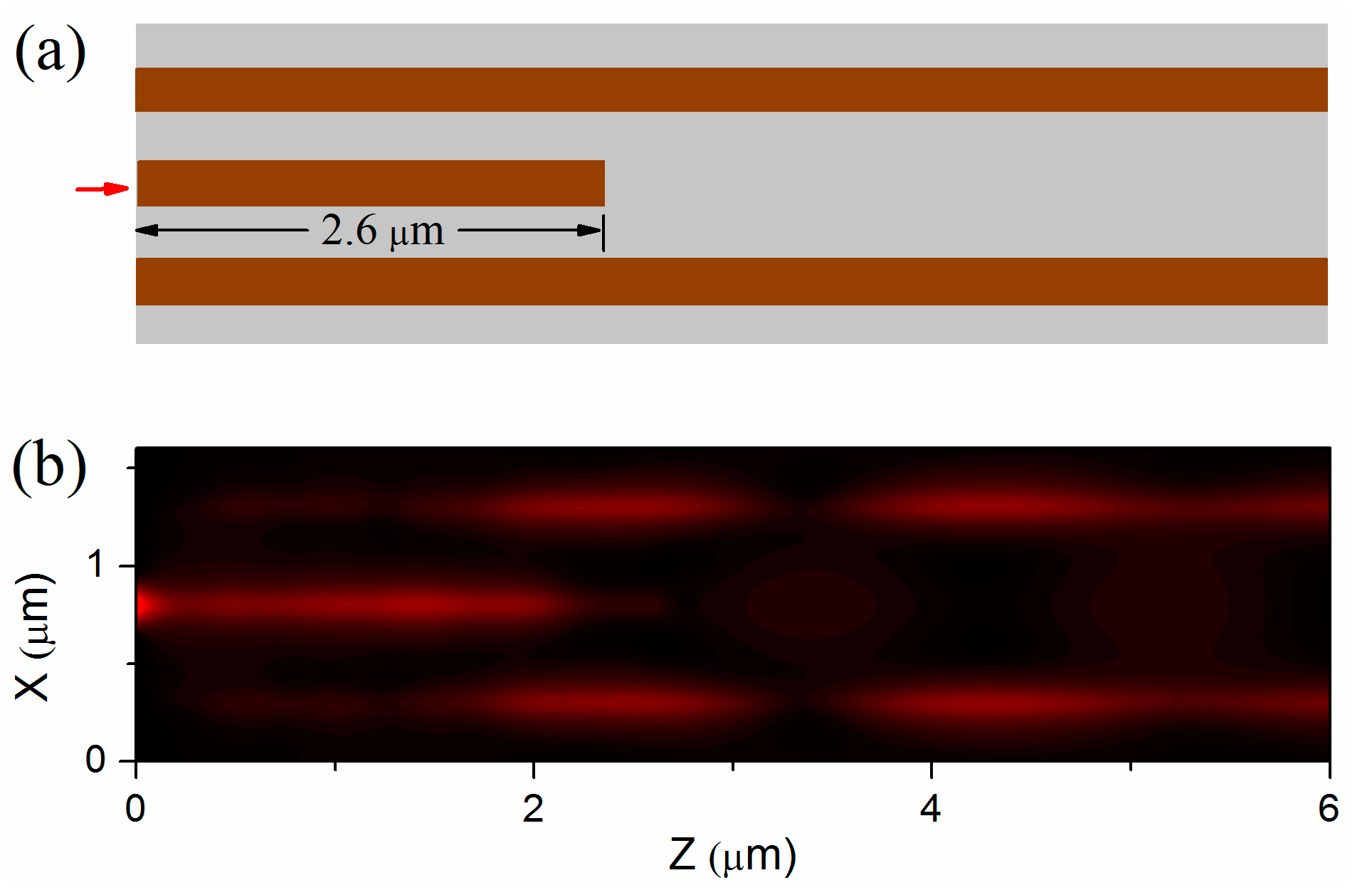
Publisher’s Note: MDPI stays neutral with regard to jurisdictional claims in published maps and institutional affiliations. |
© 2021 by the authors. Licensee MDPI, Basel, Switzerland. This article is an open access article distributed under the terms and conditions of the Creative Commons Attribution (CC BY) license (https://creativecommons.org/licenses/by/4.0/).
Share and Cite
Shi, X.; Yang, W.; Xing, H.; Chen, X. Design of Power Splitters Based on Hybrid Plasmonic Waveguides. Appl. Sci. 2021, 11, 8644. https://doi.org/10.3390/app11188644
Shi X, Yang W, Xing H, Chen X. Design of Power Splitters Based on Hybrid Plasmonic Waveguides. Applied Sciences. 2021; 11(18):8644. https://doi.org/10.3390/app11188644
Chicago/Turabian StyleShi, Xiaoyan, Wu Yang, Huaizhong Xing, and Xiaoshuang Chen. 2021. "Design of Power Splitters Based on Hybrid Plasmonic Waveguides" Applied Sciences 11, no. 18: 8644. https://doi.org/10.3390/app11188644
APA StyleShi, X., Yang, W., Xing, H., & Chen, X. (2021). Design of Power Splitters Based on Hybrid Plasmonic Waveguides. Applied Sciences, 11(18), 8644. https://doi.org/10.3390/app11188644






